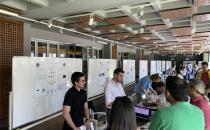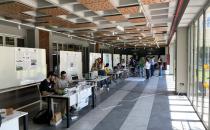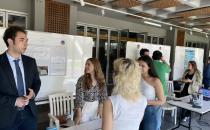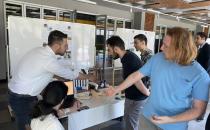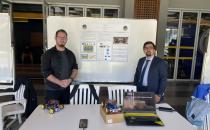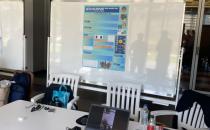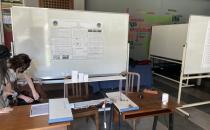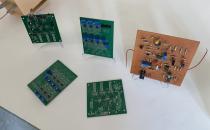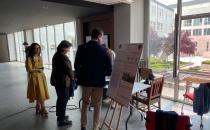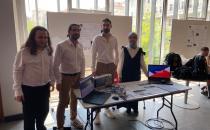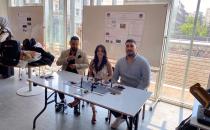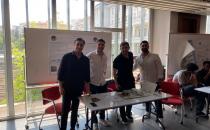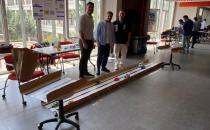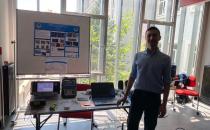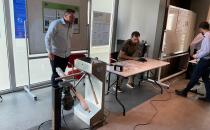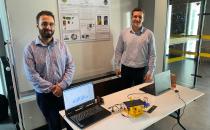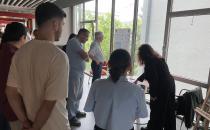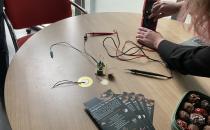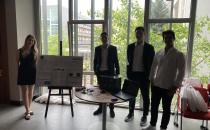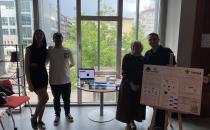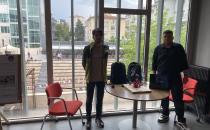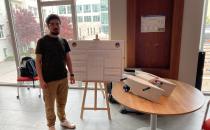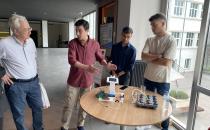The senior project of the Department of Electrical and Electronics Engineering at TED University is completed within two courses: "EE 491 – Senior Project I" and "EE 492 – Senior Project II". The EE 491 and EE 492 courses are offered in the Fall and Spring semesters. The senior project aims for students to reconcile the knowledge they have acquired in education programs with practice and to gain experience in their fields. Students can choose a senior project topic appropriate to the department courses they have taken in the department upon approval by a relevant faculty member, or faculty members can suggest a project topic to students. The senior project is generally carried out under the supervision of a single faculty member. For a project covering more than one field, more than one faculty member may act as the supervisor(s) on the project. For determining the project supervisor(s), the areas of expertise of the faculty members and the project topics must be similar. The senior project is started with the approval of faculty member(s) who will be the supervisor(s) of the project.
The first step in the EE 491 course, which is the first leg of the senior project, is to determine the project topic and the project team. The project topics should develop students' entrepreneurial spirit, improve students' ability in electrical and electronic engineering design, ensure industry-oriented and collaborative work, and provide economic and added value. The project team may consist of a single student or more than one student. If the project team consists of more than one student, team members should set a project schedule and clarify how they share the project workload.
Students should prepare two interim reports and one end-of-term report in English throughout the semester. The reports are uploaded to the Moodle system in PDF format on the specified dates. Students should meet with their project supervisor(s) regularly throughout the semester regarding the project they have stated in the interim reports. Although the project supervisor(s) directs the students for the projects, they do not take an active role in the design stages.
(a) First Interim Report:
The first interim report must be submitted at the end of the 7th week of the semester. This report defines the investigated problem and the design content of the project. The report should explain the project team, the share of the workload, and the work schedule. The report should also show the requirements and constraints needed by the problem studied in the project. Students perform background research using various sources related to the problem they are working on to acquire the necessary technical background and determine design options. Students should discuss the relevant information obtained after the background research in this report. The sections that should be included in the first interim report are as follows.
- Project description: This section provides a clear description of the design project, the purpose of its realization, and the areas in which the design can be used in the future. An explanation should be made about which of the Sustainable Development Goals (SDGs) determined by the United Nations (UN) is related to the project topic.
- Project organization: This section provides detailed information about the organization of the project. The project team and its members should be defined. If the project is planned to be completed by a team, team members should clearly state how they share the project workload. Details of the project timeline should be presented with the help of the Gantt chart. Moreover, project work management, which includes the objective of each task, expected outputs as well as possible risks, should be explained.
- Background research: This section should include a literature search, studies in the industry or subject area, and, wherever possible, different approaches to the current problem. In summary, students should compare their project topic with the available approaches in the literature and report their findings in this section.
(b) Second Interim Report:
The second interim report must be submitted at the end of the 12th week of the semester. This report discusses the advantages and disadvantages of the proposed methods and approaches for solving the design problem. At this stage, students determine the preliminary design for the project. The report should clearly state the variables that will be used and the decisions that will be taken in the preliminary design. The sections of the second term report are detailed as follows.
- Methods: Possible solutions, advantages, and disadvantages of these solutions.
- Preliminary design: Technical details, design decisions, preliminary design variables.
(c) Term Report:
The term report must be submitted on the last day of the final exams. This report documents all activities carried out during the term. The contents of the first and second reports are included as sections of this report, with any necessary updates. The content of the term report is detailed as follows.
- Project description
- Project organization
- Background research
- Methods
- Preliminary design
- Teamwork (if the project is carried out by a team): This section describes the share of the workload among the team members, the changes in the workload throughout the term, the contribution of each team member to the project, and how efficient the teamwork is.
- Estimated cost analysis: The project’s estimated cost analysis should be carried out and evaluated in terms of economic feasibility.
- Comments and results: At the end of this period, the results obtained from the studies are discussed.
Grading of the EE 491 Course:
The letter grades of the EE 491 course are determined according to the following rubric.
| Report | Percentage |
|---|---|
| First Interim Report | 30% |
| Second Interim Report | 30% |
| Term Report | 40% |
First Interim Report:
| Report Section | Points |
|---|---|
| Project description | 15 |
| Project’s relation to the UN SDGs | 5 |
| Project organization | 30 |
| Background research | 40 |
| Report format and style | 10 |
Second Interim Report:
| Report Section | Points |
|---|---|
| Methods | 50 |
| Preliminary design | 40 |
| Report format and style | 10 |
Term Report:
| Report Section | Points |
|---|---|
| Project description | 5 |
| Project organization | 5 |
| Background research | 5 |
| Methods | 15 |
| Preliminary design | 20 |
| Teamwork | 20 |
| Estimated cost analysis | 5 |
| Reviews and results | 15 |
| Report format and style | 10 |
The "EE 492 – Senior Project II" course is a continuation of the project that started with the EE 491 course. In this course, students obtain a prototype by continuing the preliminary design they developed in the EE 491 course. During this course, the students in the project team and the project's advisor(s) remain the same. The project team should obtain prototypes by performing at least two design iterations. A design iteration includes the work of repeating the necessary steps to improve a process and achieve the targeted result. A typical design cycle consists of (i) generating a solution, (ii) implementing the solution, and (iii) testing and evaluating the results obtained with the implemented solution steps. The above three processes are repeated until the results reach the targets. During the design iteration, the project team regularly discusses with the supervisor(s) the consistency and performance of the variables identified in the preliminary design. The project supervisor(s) do not carry out the design directly, instead, the supervisor(s) need to the project team properly. The students perform the following tasks during the design process:
- Develop software and/or hardware prototype for the preliminary design developed in EE 491 course.
- Test and interpret the design variables using the developed prototype.
- Update the design variables at each design iteration.
- Decide on the final design at the end of this iterative process.
The prototype should be submitted to the project supervisor(s) together with an interim report.
(a) Interim Report:
The interim report must be submitted at the end of the 10th week of the semester. This report consists of the following sections.
- Prototype: The software and/or hardware prototype obtained is explained.
- Design iterations: Each design iteration is presented as a subsection. The observations made during the iterations, the results obtained, the interpretations of these results, the changes made in the design choices and variables, and their reasons are explained.
(b) Final Report:
The final report must be submitted on the last day of the final exams. The final report includes the following sections:
- Project description
- Project organization
- Background research
- Methods
- Preliminary design
- Prototype
- Design iterations
- Details and cost analysis of the final design: The final design should be presented in detail, a corresponding cost analysis should be provided, and the results should be compared with the previous estimated cost analysis.
- Teamwork (if the project is group-led): Design iterations should include both the iterations presented in the interim report and later iterations.
(c) Poster Presentation:
The students present their final projects using posters at a senior design project exhibition, which will be organized before the spring semester final exams. All students who have taken the EE 491/492 courses must attend this exhibition with their posters and demo products. The fair is open to anyone who wants to visit. The jury consisting of all faculty members offering EE 491/492 courses will evaluate the poster presentations. The poster presentations will be evaluated according to the following criteria: (1) adequacy of research, (2) the integrity of form and content, (3) the novelty of the approach, and (4) the analytical approach.
Grading of the EE 492 Course:
The letter grades of the EE 492 course are determined according to the following rubric.
| Report | Percentage |
|---|---|
| Interim Report | 25% |
| Poster Presentation | 25% |
| Final Report | 50% |
Interim Report:
| Report Section | Points |
|---|---|
| Prototype | 50 |
| Design iterations | 40 |
| Report format and style | 10 |
Final Report:
| Report Section | Points |
|---|---|
| Project description | 5 |
| Project organization | 5 |
| Background research | 5 |
| Methods | 5 |
| Preliminary design | 5 |
| Prototype | 5 |
| Design iterations | 5 |
| Details and cost analysis of the final design | 20 |
| Teamwork | 15 |
| Reviews and results | 20 |
| Report format and style | 10 |
Useful Documents
Student Projects
2024
Simulating the Panama Canal’s Lock System for Hydroelectric Power.
Energy-Efficient LoRa-Based Wireless Communication System.
Solar Powered Smart Irrigation System.
Wireless Inventory Tracking System.
DC-DC/AC-DC Converter.
Unmanned Surface Vehicle Project.
Alternative Power Supply for EV Batteries: Harvesting Electrical Power from Piezo Sensors.
Robotic Arm.
The Elevator Wind Sensing Module.
Smartwatch for Dimentia Patents.
2023
Design Of ARINC-429 Communication Protocol.
Rendezvous Problem Of Robot Swarms.
Tracking The Sun With Cooling System.
Semi-Autonomous Vehicle Project.
Smart Traffic Light System.
Importance Of Solar Tracking Panel.
Emergency Communication System with GPS-Supported Shortwave Radio Frequency.
Bluetooth Remote Control Car Using Arduino.
Bridgify: A Smart Translation Companion.
Generating Electrical Energy from Rotating Turnstiles.
Blue Power.
Moving Object Detection with MATLAB.
2022
ECG Signal Transmission via Visible Light Communication Technology.
Wireless Charging Roads for Electric Cars.
Rendezvous Problem of Robot Swarms.
Atmospheric Water Generator.
Robotic Arm That Retrieves Cups for The Elderly and the Differently Abled.
SAR Image Reconstruction Using MATLAB.
Early Warning System For Earthquakes.
Early Flood Detection and Alert System by Monitoring Infrastructure Water Levels.
Led Lumi̇naries for Power Echonomy Street Smart Lightning.
Pressure Based Digital Posture Display.
Image Reconstruction Using Brain Activity With AI.
Talking Vehicles.
Audio Steganography with Using MATLAB.
Smart Launcher.
Herd Tracking Drone with LiDAR.
Graduation Projects Exhibition
